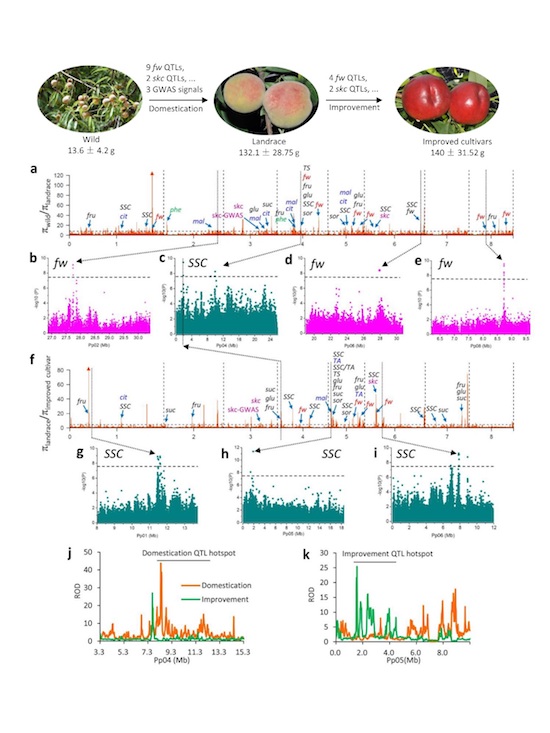Genomic analyses provide new insights to the breeding history of peach
A new article that described the genetic basis of breeding history of peach based on genome sequencing of 480 accessions was published on Genome Biology on February 22, 2019. This study provides new insights to the genetic footprints for peach domestication and improvement and reveals how human selection shapes the genomes, the finding is helpful for future peach genomic selection and molecular breeding. This study was mainly accomplished by Prof. Lirong Wang’s lab of Zhengzhou Fruit Research Institute, CAAS, in cooperation with Prof. Wenwu Guo from Huazhong Agricultural University and Prof. Zhangjun Fei from Boyce Thompson Institute for Plant Research in Cornell University.
Peach originates from China with abundant genetic resources. The research group sequenced a total of 480 wild and cultivated peach accessions from around the world which captured more than 95% genetic diversity of the collection of 1,410 accession in National Peach Germplasm Repository of China (Zhengzhou). Based on sequencing data, they constructed the hitherto biggest variation map for peach. Using the variation map, researchers performed the genome-wide association study (GWAS) on 11 important agronomic traits and mine several novel associated loci, which provide candidate for marker development and molecular breeding. a total of 142 and 104 selective sweeps during domestication and improvement, were identified respectively. Most of selective sweeps harbor the loci related to agronomic traits (See following figure). By focusing on a set of quantitative trait loci (QTLs), evidence is provided to support that distinct phases of domestication and improvement have led to an increase in fruit size and taste and extended its geographic distribution. Fruit size was predominantly selected during domestication, and selection for large fruits has led to the loss of genetic diversity in several fruit weight QTLs. In contrast, fruit taste-related QTLs were successively selected for by domestication and improvement, with more QTLs selected for during improvement. Novel loci for chilling requirement and candidate loci for genes that contributed to the adaption to low-chill regions were identified. Moreover, a PCR-based marker for early selection of low chilling requirement was developed. Furthermore, the genomic bases of divergent selection for fruit texture and local breeding for different flavors between Asian and European/North American cultivars were also determined.

Figure Genome-wide detection and functional annotations of selection sweeps during domestication and improvement.
The article served as an important development step of the 1,000 Peach Genome Project designed and implemented by Wang’s lab. Her lab has previously published two articles focusing on peach genomics on Genome Biology and Nature Communications in 2014 and 2016, respectively. This article comprehensively elucidates the genomic footprints of artificial selection during domestication and improvement, which provides important resources for future molecular design breeding.
The first author and corresponding author are PhD candidate Yong Li and Prof. Lirong Wang, respectively. This study was supported by the grants from the National Natural Science Foundation of China (31572094), the Agricultural Science and Technology Innovation Program (CAAS-ASTIP-2018-ZFRI-01), and Crop Germplasm Resources Conservation Project (2016NWB041).
The URL for this article should be:
https://genomebiology.biomedcentral.com/articles/10.1186/s13059-019-1648-9
By Yong Li
jay20075267@163.com
-
 Apr 18, 2024Opening Ceremony of the Training Workshop on Wheat Head Scab Resistance Breeding and Pest Control in Africa Held in CAAS
Apr 18, 2024Opening Ceremony of the Training Workshop on Wheat Head Scab Resistance Breeding and Pest Control in Africa Held in CAAS -
 Apr 03, 2024IPPCAAS Co-organized the Training Workshop on Management and Application of Biopesticides in Nepal
Apr 03, 2024IPPCAAS Co-organized the Training Workshop on Management and Application of Biopesticides in Nepal -
 Mar 28, 2024Delegation from the School of Agriculture and Food Science of University College Dublin, Ireland Visit to IAS, CAAS
Mar 28, 2024Delegation from the School of Agriculture and Food Science of University College Dublin, Ireland Visit to IAS, CAAS -
 Mar 25, 2024Director of World Food Prize Foundation visited GSCAAS
Mar 25, 2024Director of World Food Prize Foundation visited GSCAAS -
 Mar 20, 2024Institute of Crop Sciences (ICS) and Syngenta Group Global Seeds Advance Collaborative Research in the Seed Industry
Mar 20, 2024Institute of Crop Sciences (ICS) and Syngenta Group Global Seeds Advance Collaborative Research in the Seed Industry
